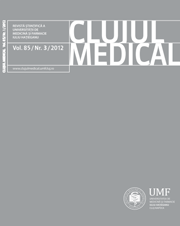The Frequency of Systolic Disfunction May Be Correlated with the Incidence of Acute Coronary Syndrome in Patients with Degenerative Aortic Stenosis: a Prospective Clinical Study
Keywords:
systolic dysfunction, degenerative aortic stenosis, acute coronary syndromeAbstract
Objective. Patients with preexistent aortic valve disease represent approximately 5% of the total number of patients with acute coronary syndrome (ACS): they are at high cardiovascular risk with a reserved prognosis.
Material and Methods. Starting with 2006, a group of 196 patients consecutively hospitalized within the cardiology ward of the Emergency County Hospital of Baia Mare, aged 56 to 94, with different grades of degenerative AS, underwent prospective assessment over a period of 5 years.
Results. A number of 54 patients (27.6%) developed ACS and 67 (34.2%) had left ventricular systolic dysfunction (LV) documented by echocardiography: Eleven (11) had LV severe systolic dysfunction, defined by EF under 30% (7 from the ACS group), 28 had moderate systolic dysfunction, defined by EF between 30-40% (13 from the ACS group) and 28 had mild systolic dysfuntion, defined by EF between 40-50% (8 from the ACS group). The ACS risk was 5.14 times higher in patients with severe systolic dysfunction (OR 5.14, 95% CI 1.43-18.34, p=0.0117), 2.68 times higher in patients with moderate systolic dysfunction (OR 2.68, 95% CI 1.18-6.11, p=0.0185) and 1.06 times higher in patients with mild systolic dysfunction (OR 1.06, 95% CI 0.44-2.57, p=0.8961) The cumulative risk for developing ACS was OR=2.84, 95% CI 1.48-5.44, p=0.0016 in patients with AS and LV dysfunction, while the cumulative incidence of ACS was 41.8%.
Conclusion. Patients with degenerative AS and LV systolic dysfunction have an increased risk of developing ACS. It is of top priority to identify these patients and to establish an optimal medical/surgical therapeutical regimen in order to achieve a better prognosis, aggravated by the increased incidence of ACS.
Downloads
Published
How to Cite
Issue
Section
License
The authors are required to transfer the copyright of the published paper to the journal. This is done by agreeing to sign the Copyright Assignment Form. Whenever the case, authors are also required to send permissions to reproduce material (such as illustrations) from the copyright holder.

The papers published in the journal are licensed under a Creative Commons Attribution-NonCommercial-NoDerivatives 4.0 International License.

